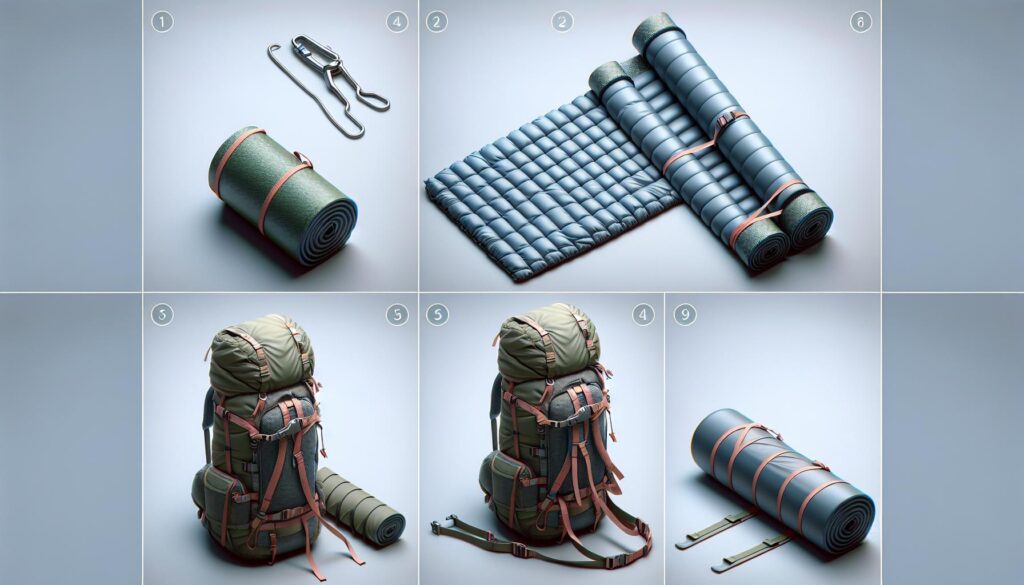Finding the best way to attach a sleeping pad securely to your backpack can seem challenging, but with a few straightforward steps, you can make sure your pad doesn’t shift or drop during your outdoor adventures.
With the following steps, you can ensure a steady and trouble-free method to fasten a sleeping pad to your backpack. Start by rolling the pad as tightly as possible and place it upright against your backpack’s back. Once it’s in the correct position, secure the pad with compression straps or bungee cords.
These practical steps go a long way to guarantee that your packed sleeping pad remains intact, avoiding dislocation or loss on your exciting outdoor expedition.
Table of Contents
Securing With Straps or Compression Straps
One of the easiest and most straightforward ways to attach a sleeping pad to your backpack is by using straps or compression straps generally found on the backpack’s exterior and can be adjusted for a perfect fit.
Aligning the Sleeping Pad on the Backpack Vertically
For starters, place the sleeping pad in a vertical position on your backpack’s back. This positioning helps distribute the weight evenly and helps maintain a good balance during hiking. Once in place, tie the pad firmly to the backpack using these adjustable straps.
Tightening the Sleeping Pad Using Adjustable Straps
Secure the adjustment straps around the sleeping pad to hold it firmly. However, avoid overtightening, which could introduce discomfort or strain on the backpack. Ensure that the sleeping pad aligns with the backpack’s frame for additional stability.
Adjusting the Straps for a Perfect Fit
If necessary, tweak the adjustable straps to achieve an ideal fit. This can help keep your sleeping pad from moving and shifting during your outdoor expedition. Before you set off, make sure you double-check your straps’ tightness.
Leveraging Webbing Loops or Attachments
The ability to fasten a sleeping pad correctly to your backpack can make or break your camping or hiking experience. An effective approach includes utilizing webbing loops or sturdy attachment points. These are usually found on the backpack’s exterior and can be recognized by their distinctive arrangement and shape. As soon as you spot the attachment points, you can proceed to loop the sleeping pad straps through them. Ensuring the straps are tightly fastened is crucial to prevent potential slipping or shifting during movement. An adequately secured sleeping pad can elevate your outdoor adventure by providing a stable and secure rest zone.
Opting for a Sleeping Pad Sleeve or Designated Attachment System
One popular option among hikers is to use a special sleeping pad sleeve or a designed attachment system specifically made for this purpose. These systems offer a hassle-free and secure way to carry your sleeping pad while hiking or backpacking.
There are several advantages of using a designated attachment system. Primarily, it guarantees that your sleeping pad stays steady while you are on the trail, thus eliminating frequent readjustments. Also, it safeguards your sleeping pad from shifting and potentially poking you during the hike. Notably, it frees up space within your backpack for storage of other essential items.
Usually, attaching the sleeping pad to the sleeve or the specific system is an easy process. You can effortlessly slide the sleeping pad into the sleeve or connect it to the attachment points. Always test the system’s integrity and adjustability before hitting the trail to guarantee unyielding steadiness throughout your hike.
Limiting Movement and Shifting During Expeditions
Ensuring stability of your sleeping pad is vital for a relaxed hiking experience. Before embarking on your journey, firmly secure the sleeping pad to your backpack using designated straps or loops, ensuring it feels steady and safe.
During your hike, habitually inspect the attachment of the sleeping pad to ensure consistent stability. Monitor any signs of shifting or movement while hiking. If you detect any signs of instability, make the necessary alterations to avoid additional movement.
For improved hiking experience and peaceful overnights, take immediate action if you notice any sudden movement. Tighten the straps if they appear loose, or reconfigure the attachments to maintain safety. Active steps to curtail movements and shifts will help towards a peaceful hiking experience.
Considering the Weather and Terrain
Securing your sleeping pad is important, but considering the terrain and weather conditions is crucial. Adjustments needed for steep or challenging trails are important for maintaining balance while hiking. Proper attachments do not interfere with your movements or impact your center of gravity.
In adverse weather conditions, it is advisable to take additional precautions to prevent the sleeping pad from getting wet or damaged. These precautions may include the use of waterproof covers or bags and ensuring proper insulation from the ground.
Preserving the Integrity of the Sleeping Pad and Backpack
Frequent checking of points of attachments and straps helps maintain both your sleeping pad and backpack. Avoid attaching a wet sleeping pad to your backpack as it can foster mold and unpleasant odors. Correct storage of the sleeping pad when not in use can avoid damage or deformation. Complying with the manufacturer’s instructions on rolling or folding the sleeping pad and storing it in a dry, clean location extends its lifespan, ensuring a comfortable and enjoyable outdoor experience.
Answers To Common Questions About Attaching A Sleeping Pad To Your Backpack
The process of securely attaching a sleeping pad to your backpack can appear challenging. Let’s explore and answer some frequently asked questions to aid you on your hiking adventures.
Q: What’s the best method to attach a sleeping pad to a backpack while hiking?
A: Securing a sleeping pad to a backpack during your hiking trips entails using the backpack’s external attachment straps or looping the pad straps through the backpack’s compression straps. It’s vital to fasten the pad snugly to prevent it from falling and to achieve a balanced weight distribution.
Q: Are there any advantages to attaching a sleeping pad to a backpack?
A: Absolutely! Fastening a sleeping pad to your backpack offers several benefits. It saves valuable space inside the backpack, providing more room for storage. It ensures easy access to your sleeping pad during breaks. Also, when properly attached, it enhances stability and improves weight distribution, making your hiking expeditions more pleasant.
Q: Can any sleeping pad be attached to a backpack?
A: Majority of backpacks come with compatible attachment points, enabling easy fastening of various sleeping pads. Nonetheless, it’s crucial to check the guidance of both the backpack and the sleeping pad’s attachment system beforehand. Some backpacks might need additional straps or modifications to comfortably accommodate certain sleeping pad designs.
Q: Are there alternate techniques for attaching a sleeping pad to a backpack?
A: Certainly, other than using external attachment straps or compression straps, explorers have options like bungee cords, carabiners, or lightweight resting pad holders. These alternative methods provide flexibility, allowing you to secure your sleeping pad based on the available attachment points and individual preferences.
Wrapping Up
Fastening a sleeping pad to your backpack is a relatively straightforward task and fundamental for any nature enthusiast. By carefully following these steps, you can ensure the secure fastening of your sleeping pad, making it easily accessible throughout your camping or hiking escapades.
Don’t forget to consider your backpack type and choose the method most suitable for you. Now, equipped with this knowledge, you are ready to kick off your next outdoor journey with comfort and ease. Happy hiking!
Demystifying The Art Of Attaching A Sleeping Pad To Your Backpack
Securing a sleeping pad to your backpack might seem daunting at first glance. To help alleviate this, we have put together some common questions and their answers to guide you through this process. So, let’s dive in.
Q: What is the recommended way of attaching a sleeping pad to a backpack during hikes?
A: To secure a sleeping pad to your backpack while hiking, consider using the external attachment straps on your backpack or thread the sleeping pad straps through your backpack’s compression straps. It is crucial to securely fasten it to prevent falling and achieve balanced weight distribution effectively.
Q: What exactly are the advantages of attaching a sleeping pad to my backpack?
A: There are several benefits of carrying a sleeping pad attached to your backpack. Not only does it provide more storage within your backpack, but it also offers convenience in accessing the sleeping pad whenever needed. A crucial aspect is that a properly secured sleeping pad promotes stability and enhances weight distribution, making your hiking journey more enjoyable.
Q: Can all kinds of sleeping pads be attached to a backpack?
A: While most backpacks do feature compatible attachment points that accommodate various sleeping pads, it’s critical to verify this by checking the specifications of both your backpack and the sleeping pad’s attachment system. Do keep in mind, some backpacks might require additional straps or special adjustments in order to accommodate certain types of sleeping pad designs.
Q: Are there any alternative methods for attaching a sleeping pad to my backpack?
A: Indeed, besides using external attachment straps or compression straps, options like bungee cords, carabiners, or lightweight sleeping pad holders present more flexible solutions. These alternative methods offer more freedom in securing your sleeping pad to your backpack. Picking one depends on the type of available attachment point and your personal preference.
In Summary
The task of securely attaching a sleeping pad to your backpack is a straightforward yet essential part of any outdoor expedition. Following these steps ensures that your sleeping pad will not only be securely fastened but also readily accessible during your camping or hiking journeys.
Always remember to consider the type of your backpack and choose a method that suits your needs the best. Armed with this practical knowledge, you’re well-prepared for your upcoming outdoor adventure, aiming for comfort and ease. Here’s to happy hiking!














